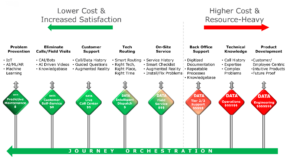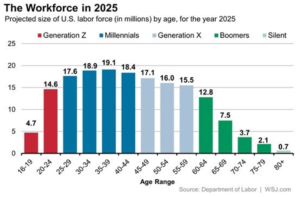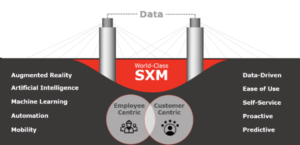Solving your customers’ problems is not a single event or action. It is a series of events that happen overtime. The more time that elapses from when the customer perceives there is a problem to actual final resolution will determine your success as a service organization.
You cannot view your customers’ experience and your service organizations’ experience as separate workstreams. Your customers certainly do not differentiate. This merging of the two experiences into one cohesive, integrated approach is now being called Service Experience Management or SXM.
As for customer experience (CX) management, Gartner sums it up well in its definition: “the practice of designing and reacting to customer interactions to meet or exceed customer expectations and, thus, increase customer satisfaction, loyalty and advocacy.”
Customers today are also much savvier than in the past. If there is an easy way for them to resolve an issue without contacting you, most are happy to do it. However, this self-service interaction needs to:
- Be easy to understand
- Quickly solve the problem or lead them to an alternative path
- Save data so they will not lose the information communicated to your organization over all channels
- Seamlessly get to the next problem-solving step
The SXM experience will be the difference between success and failure in the future. This is especially true as an aging workforce creates a skills gap, and the pain to your customer will become more acute over time. If it is not addressed now, you may find yourself far behind your competitors who have embraced SXM.
As we see in chart below, there are many potential customer touchpoints in the SXM journey within your organization. The farther left they can end their journey, the happier they will be with the lowest cost for your organization.
Customer service is the experience you provide to your customers. If the journey is pleasant, or as pleasant as possible given the circumstance, then they will continue to purchase your goods and services and tell other people about those experiences. If they have a bad experience, they may try another supplier and they will share that negative experience with other potential customers. Almost everyone today buys based on reviews. How are your reviews?
The service journey is the promise you make to your customers that if they do business with you, they will be happy. Break that promise and they will be dissatisfied, and most people will go out of their way to let others know about their bad experiences. The service journey is how your customer “feels” about doing business with you.
Most likely, your organization has been working on providing a better CX, improving customer service and enhancing your field service organization. Has this been done as a single process or is it managed by two or three different organizations? It’s common to have a customer advocate group, a call center group, and field service management group, often reporting into different leadership organizations. The challenge is having three different systems, three different paths (or more) that the customer must deal with, at three different times, as well as other software solutions that need to be integrated.
Historically, companies have used structured data—e.g., demographic, transactional, and log data—to construct customer profiles. Today, you must include emerging types of data—social media, video, warranty, asset, service history, sensor, on-site restrictions and geolocation—tied together with cross-channel coordination. In addition, you need to add contact, response and transactional history interspersed throughout the customer lifecycle, as well as customer value, profitability, behavioral analysis and propensity scores. It’s complicated.
We often see the tools for employees as less intuitive and user friendly than for customers (although sometimes they may not be intuitive, either). One of the main causes of this unfriendly solution is older technology, when the employee environment was very different. Today, you cannot dictate how your employees work with your systems, they can pick and choose the companies they want to work for, and often it is the way they interact on a day-to-day basis with their support systems that keeps them satisfied or looking elsewhere. The employee is the new customer. If your systems are older than five years, you need to take a hard look on how employees, especially anyone hired in the last three years, feel about the systems.
The status quo of CX today is mediocre at best. Customers make this clear, year after year.
- 73% of customers globally point to CX as an important factor in their purchasing decisions.
- But 54% of U.S. customers say CX at most companies needs improvement.
Source: PwC
INFORMATION FLOW
Another key aspect of your service solution is the ability for information to flow seamlessly and fully automated between touchpoints. If a customer starts a journey with a self-service portal, then chats online, and then talks to a live person, does that interaction and content flow to everyone in the journey, then ultimately to the field service technician?
We have repeatedly seen each of the touchpoints be different vendor solutions, with different data structures, user interfaces and even different workflows. This creates a disjointed journey for everyone. Having an end-to-end solution purposely build for this process is what the next generation of technology will address. It is taking omnichannel or multi-channel to a whole new level. No matter where the customer or employee is in the SXM journey, all information is presented in the right format, at the right time.
Customer data collected at every step along the SXM journey needs to be presented to the next person in the service journey process in the correct context for them. The call center agent will require different information, in a different format than the field service technician when they are on-site. This data transformation and presentation is key to the success of the SXM journey.
WHAT’S DIFFERENT TODAY FROM JUST A FEW YEARS AGO?
Your employees are more digital savvy. They grew up using iPhones and Androids, not PCs. They play interactive games and use social media to communicate, shop and express their feelings. This is true of your customers as well. The chart below shows that each generation has a different approach to technology.
Have your systems kept up? If you deployed a field service management solution 10, even five years ago, is it the right solution to address today’s SXM journeys? Is it equipped for future journeys? Just getting a tech to a customer’s location in the most efficient manner possible is not enough in today’s digital world. CX, employee experience (EX) and the overall service journey have all changed.
Today, many field service organizations take a break-fix reactive approach and send a tech out to a customer as fast and efficiently as possible. This can cost hundreds of dollars to over a thousand dollars—plus, think of the opportunity cost of sending a service tech to a customer who could have fixed it faster using online technology and NOT going to a customer who really needs an on-site visit. Now you have negatively affected two customers, as well as the service tech.
CHANGING WORKFORCE – GENERATION Z
- Born between 1995 and mid-2000s
- Make up 24% of global workforce today, will be 40% by 2025
- Prefer to communicate via text, instant messaging and email
- Not bound by work schedules (work anywhere, at any time)
- Use social media differently (YouTube, SnapChat, Instagram
Understanding the generational tech divide will give your organization a competitive advantage. Whether it’s updating field service software or improving the way people communicate—face-to-face, phone, emails, chat or text— you can alter behaviors and respect each generation’s wants and needs. This will ensure future business success and deliver world-class customer, employee and service experiences.
BUILDING A BRIDGE TO WORLD-CLASS SXM
At CSG, we have been focused on building a bridge between all the various data silos, whether they are a CSG product or not.
Using a common communications fabric like journey orchestration, combined with no-code architecture, and leveraging advanced technologies like machine learning, augmented reality, and other emerging solutions, CSG can help you create a world-class employee and customer experience. Learn more about CSG field service management.




